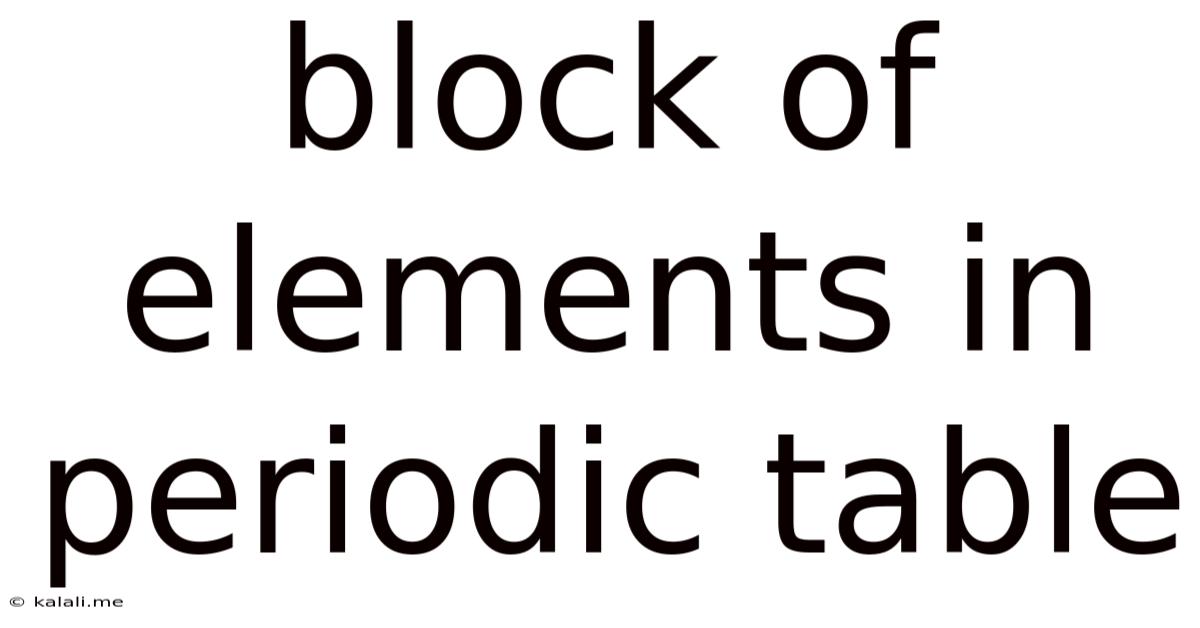Block Of Elements In Periodic Table
Kalali
Jun 11, 2025 · 4 min read

Table of Contents
Understanding Blocks of Elements in the Periodic Table
The periodic table is a cornerstone of chemistry, organizing elements based on their atomic structure and properties. While the rows (periods) represent increasing electron shells, and columns (groups) show similar chemical behaviors, the table is further divided into blocks—a crucial aspect often overlooked. This article delves into the four main blocks: s-block, p-block, d-block, and f-block, explaining their characteristics and significance. Understanding these blocks unlocks a deeper understanding of elemental properties and periodic trends.
What are the blocks of elements? The blocks are regions of the periodic table determined by the electron subshell into which the last electron of an atom is added. This electron configuration directly impacts an element's chemical reactivity and physical properties.
1. The s-block: Alkali and Alkaline Earth Metals
The s-block occupies the first two groups of the periodic table. It's characterized by elements having their valence electrons (outermost electrons) in the s subshell. This means their electron configuration ends in ns<sup>1</sup> or ns<sup>2</sup>, where n represents the principal quantum number (energy level).
-
Alkali Metals (Group 1): Highly reactive metals with one valence electron. They readily lose this electron to form +1 ions. Examples include lithium (Li), sodium (Na), and potassium (K). Their reactivity increases down the group.
-
Alkaline Earth Metals (Group 2): These metals are also reactive, though less so than alkali metals. They have two valence electrons and typically form +2 ions. Examples include beryllium (Be), magnesium (Mg), and calcium (Ca). Their reactivity also increases down the group.
2. The p-block: Diverse Properties and Reactivity
The p-block occupies groups 13 to 18. Elements in this block fill their p subshell with electrons. Their electron configuration ends in ns<sup>2</sup>np<sup>1-6</sup>. This block encompasses a vast range of elements with diverse properties.
-
Nonmetals: Many nonmetals reside in the p-block, such as oxygen (O), nitrogen (N), chlorine (Cl), and the noble gases (Group 18). These elements tend to gain electrons to achieve a stable electron configuration.
-
Metalloids: This group sits between metals and nonmetals, exhibiting properties of both. Silicon (Si), germanium (Ge), and arsenic (As) are prominent examples. Their conductivity varies with temperature and other factors.
-
Post-transition Metals: Elements like aluminum (Al), tin (Sn), and lead (Pb) are considered post-transition metals; they display metallic characteristics but are less reactive than transition metals.
3. The d-block: Transition Metals and Their Characteristics
The d-block, located in groups 3 to 12, comprises the transition metals. These metals fill their d subshell with electrons. Their electron configurations end in (n-1)d<sup>1-10</sup>ns<sup>1-2</sup>.
-
Variable Oxidation States: Transition metals are known for their ability to exhibit multiple oxidation states (charges) due to the involvement of both d and s electrons in bonding. This results in a variety of compounds with diverse colors and properties.
-
Catalysis: Many transition metals and their compounds act as catalysts in various chemical reactions, significantly influencing reaction rates. This property is crucial in industrial processes and biological systems.
-
Complex Ion Formation: Transition metals readily form complex ions by coordinating with ligands (molecules or ions). This ability plays a vital role in coordination chemistry and biochemistry.
4. The f-block: Lanthanides and Actinides
The f-block, located separately at the bottom of the periodic table, houses the lanthanides (rare earth elements) and actinides. These elements fill their f subshell with electrons, exhibiting similar chemical properties within each series. Their electron configurations end in (n-2)f<sup>1-14</sup>(n-1)d<sup>0-1</sup>ns<sup>2</sup>.
-
Lanthanides: Relatively reactive metals with similar chemical properties due to the similar shielding effect of the 4f electrons.
-
Actinides: Most are radioactive elements, with only a few occurring naturally. They are highly reactive and exhibit complex chemistry.
Understanding the block structure of the periodic table provides a powerful framework for predicting and explaining the properties of elements. By recognizing the electron configurations associated with each block, we gain invaluable insight into chemical reactivity, bonding, and the rich diversity of the elements around us.
Latest Posts
Latest Posts
-
Four Letter Word With Second Letter A
Jul 01, 2025
-
How Many 1 8 Cups Are In 2 3 Cup
Jul 01, 2025
-
How Many Slices Of Turkey In 2 Oz
Jul 01, 2025
-
Omnipoint Miami E License Llc Miami Fl
Jul 01, 2025
-
Mi Familia Fuera La M S Grande Correct Incorrect
Jul 01, 2025
Related Post
Thank you for visiting our website which covers about Block Of Elements In Periodic Table . We hope the information provided has been useful to you. Feel free to contact us if you have any questions or need further assistance. See you next time and don't miss to bookmark.